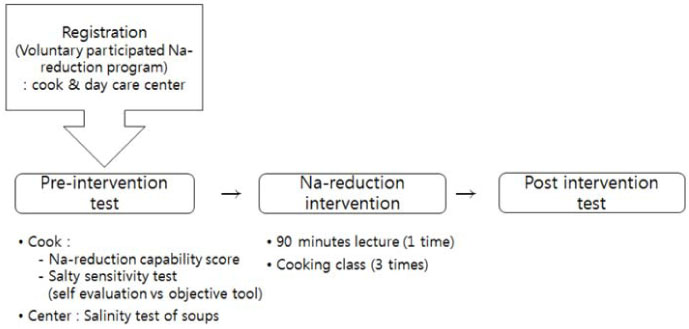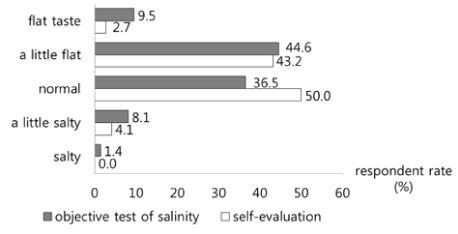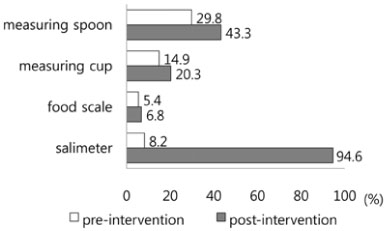Korean J Community Nutr.
2014 Oct;19(5):425-435. 10.5720/kjcn.2014.19.5.425.
The Effectiveness of Na Reduction Program for Cook in Child-care Center: Focus on Self-reevaluation and Strengthen Consciousness
- Affiliations
-
- 1Department of Food & Nutrition, Graduate School of Gacheon University, Seongnam, Korea. leeym@gachon.ac.kr
- KMID: 2268106
- DOI: http://doi.org/10.5720/kjcn.2014.19.5.425
Abstract
OBJECTIVES
The purpose of this study was to develop a Na-reduction education program and apply it for cooks who prepare meals in day-care centers. To development of the program was based on increasing the self-awareness of salinity, eating behaviors and enforcing skills of low-Na cooking.
METHODS
The study was carried out from April to October in 2013, fifty five cooks participated in this program. The Na reduction program composed of 4 sessions of education which included a 90-minute lecture and self-reevaluation of personal saltsensitivity degree and three low Na recipe cooking classes. In order to measure the effectiveness of the program, the pretest and posttest of salinity of the soups provided by day care centers was conducted at registration and 5 month after the program with the same menu.
RESULTS
After the conduct of the program, salimeter using rate was increased from 8.2% to 94.6% after the program and the other measuring instruments using rate was gradually increased. We observed that the score on eating behaviors increased 1.51 points from 38.80 to 40.31 after the intervention program (p < 0.001). Further, increased knowledge and skill provided by the intervention program resulted in improved Nareduction cooking capability. According to the results from analyzing the soup salinity, the salinity in watery soup was significant reduced from 0.556 to 0.449 0.107 and soybean-paste soup was significant reduced from 0.669 to 0.551 after the intervention program (p < 0.001).
CONCLUSIONS
As the result of fact, the intervention programs that was based on self-reevaluation, to enforce practical skill and consciousness was effective to serve low sodium menu at day care centers.
Keyword
MeSH Terms
Figure
Cited by 2 articles
-
Nutrition knowledge, eating attitudes, nutrition behavior, self-efficacy of childcare center foodservice employees by stages of behavioral change in reducing sodium intake
Yun Ahn, Kyung Won Kim, Kyungmin Kim, Jinwon Pyun, Ikhyun Yeo, Kisun Nam
J Nutr Health. 2015;48(5):429-440. doi: 10.4163/jnh.2015.48.5.429.Changes in the importance and performance of low-sodium management among childcare center cooks in Yongin, South Korea, after salinometer support programs: a descriptive study
Jiwoo Min, Youngmi Lee, Yunhee Chang, Yujin Lee
Korean J Community Nutr. 2024;29(4):304-317. doi: 10.5720/kjcn.2024.00004.
Reference
-
1. Ahn HS, Lim HJ. Analysis of factors associated with the preschool children's nutrition awareness. Korean J Diet Cult. 1994; 9(3):311–321.2. An MA. A study on school foodservice employee's characteristics related sodium intake and estimating sodium intake by Dish Frequency Questionnaire (DFQ) in Jeon-ju. MS thesis. Chonbuk National University;2009. 57–68.3. Chang SO. The amount of sodium in the processed foods, the use of sodium information on the nutrition label and the acceptance of sodium reduced ramen in the female collage students. Korean J Nutr. 2006; 39(6):585–591.4. He FJ, Marrero NM, MacGregor GA. Salt intake is related to soft drink consumption in children and adolescents: a link to obesity? Hypertension. 2008; 51(3):629–634.5. Jung EJ, Son SM, Kwon JS. The effect of sodium reduction education program of a public health center on the blood pressure, blood biochemical profile and sodium intake of hypertensive adults. Korean J Community Nutr. 2012; 17(6):752–771.6. Jung HR, Lee MJ, Kim KC, Kim JB, Kim DH, Kang SH, Park JS, Kwon KI, Kim MH, Park YB. Survey on the sodium contents of nursery school meals in Gyeonggi-do. J Korean Soc Food Sci Nutr. 2010; 39(4):526–534.7. Kim HY, Kim JH. Effects of dietary education on low-sodium diet adaptation. Korean J Food Cult. 2014; 29(2):212–221.8. Kim JN, Park SY, Ahn SH, Kim HK. A survey on the salt content of kindergarten lunch meals and meal providers' dietary attitude to sodium intake in Gyeonggi-do area. Korean J Community Nutr. 2013; 18(5):478–490.9. Kim SH, Chang SY, Choi JK. Taste preference and wholemouth taste threshold in a Korea population in the age of the 3rd decade. Korean J Oral Medicine. 2003; 28(4):413–426.10. Lee GY. Dietary guidelines for Korean. Korean J Nutr. 1986; 19(2):81–105.11. Lee KH, Choi IS, Oh SH. A study on intake/excretion of sodium and calcium in Korean children. Korean J Nutr. 1995; 28(8):749–758.12. Lee K. Use of salimeters and sodium reduction education in school foodservice in the Gyeonggi area. J Korean Diet Assoc. 2013; 19(2):173–181.13. Lee YM, Lee MJ. Nutrition Education. Seoul: Shinkwang publisher;2005. p. 356–357. p. 41014. Lee Y, Oh YJ. Parent's perception and attitudes to the School Meal Service Program(SMSP) in kindergarten. Korean J Community Nutr. 2005; 10(2):141–150.15. Lee Y, Park HN. The effectiveness of Na education program in elementary school: six month follow-up study. Korean J Community Nutr. 2010; 15(5):603–613.16. Lim HJ. A study on the calcium and sodium intakes and urinary calcium excretion of preschool children in Busan. Korean J Nutr. 2001; 34(7):786–796.17. Ministry of Health and Welfare. Korea National Health and Nutrition Examination Survey (KNHANES). 2012. p. 487.18. Park NY, Park HK, Park HJ, Seo MK, Im HR, Lim HH, Jung JH, Yoon KS. Employee food-hygiene and nutrition awareness and performance at child care centers and kindergartens located in Seoul. Korean J Food Cookery Sci. 2011; 27(2):45–59.19. Park YS, Son SM, Lim WJ, Kim SB, Chung YS. Comparison of dietary behaviors related to sodium intake by gender and age. Korean J Community Nutr. 2008; 13(1):1–12.20. Son SM, Heo KY. Salt intake and nutritional problems in Korean. Korean J Community Nutr. 2002; 7(3):381–390.21. Suh Y, Seok YH, Chung YJ. Relationship of dietary self-efficacy and illness beliefs, perceived benefits and perceived barriers for the reduction of sodium intake in the elderly. Korean J Nutr. 2012; 45(4):324–335.22. The Korean Nutrition Society. Dietary reference intakes for Koreans. Seoul: Korean Nutrition Society;2010.23. World Health Organization. The world health report 2002: reducing risk, promoting healthy life. 2002.
- Full Text Links
- Actions
-
Cited
- CITED
-
- Close
- Share
- Similar articles
-
- The Analysis of the Effects of Intervetion Program of Sensory Stimulation for Comatous Patients on Their Consciousness Status
- The Effectiveness of Na Education Program in Elementary School: Six Month Follow-up Study
- Development of an Ecological Model to Improve Health Care Management for Children in Child Care Centers
- Parent's Needs for Center-based Child Care Health Program
- The Effect of Self-Help Management Program by Strengthen Self-Efficacy on Self-Efficacy and the Activities of Daily Living in Stroke Patients




